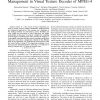Free Online Productivity Tools
i2Speak
i2Symbol
i2OCR
iTex2Img
iWeb2Print
iWeb2Shot
i2Type
iPdf2Split
iPdf2Merge
i2Bopomofo
i2Arabic
i2Style
i2Image
i2PDF
iLatex2Rtf
Sci2ools
ISCAS
2006
IEEE
2006
IEEE
Systematic design flow for dynamic data management in visual texture decoder of MPEG-4
Abstract— There is a clear trend of future embedded systems in moving toward wireless, multimedia, multi-functional and ubiquitous applications. This emerges new challenges in the existing solutions on performance, power, flexibility and costs, calling for innovations in both architecture and design methodology. In this paper we propose a design flow consisting of three stages to handle dynamic data, allowing the designer to create highly customized dynamic memory managers, make them bank-aware and create a design-time schedule of the different tasks of the application. We evaluated the proposed flow using the Visual Texture Coding (VTC) application, mapping it on a dual processor embedded platform achieving 5.5% reduction in memory footprint and 10% gains in execution time.
| Added | 12 Jun 2010 |
| Updated | 12 Jun 2010 |
| Type | Conference |
| Year | 2006 |
| Where | ISCAS |
| Authors | Alexandros Bartzas, Miguel Peón Quirós, Stylianos Mamagkakis, David Atienza, Francky Catthoor, Dimitrios Soudris, M. Mendias |
Comments (0)

